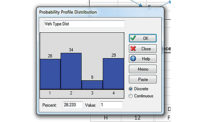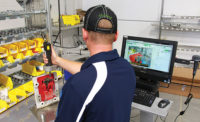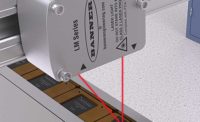Robots are being used for a variety of assembly and inspection applications, which is enabling the operation of lean, efficient and automated systems where more than one product type or model can be produced on a single assembly line.
3D smart sensors provide these systems with both robot vision-guidance and flexible measurement capabilities for inline assembly and inspection processes.
Single-Model Assembly Lines
In early automotive manufacturing layouts, single-model batch assembly lines were common. This approach consisted of a set of workstations arranged in a linear fashion, with each station connected by a material handling device.
In this layout, each station performs a fixed function in the assembly of a single product type or model. To assemble a different product type or model, the entire line has to be changed over on a fixed schedule.
Single-model assembly lines often require rebalancing with different stations and task assignments, which leads to disruption and downtime on the line. Most importantly, because they are made up of fixed workstations, single-model lines are unable to adapt to upstream demand
variability.
Mixed-Model Assembly
Mixed-model assembly increases productivity and profitability through a more efficient use of time, floor space and resources. As a complement to single-model batch assembly, mixed-model manufacturing allows the factory to create products according to specific customer demands and specifications.
As opposed to a single-model approach, the assembly line is now organized into multiple, smaller workcells where each cell can produce either a single model or several models with a high degree of part commonality. Some (or all) upstream fabrication can be carried out in each of these cells to increase efficiency and output. Fabrication equipment for each model can be combined with respective assembly operations in a cell or sub-cell––providing even closer coordination and corresponding improvements in quality and inventory.
The result is a smoothing of demand at fabrication, which eliminates the need for a large inventory buffer between fabrication and assembly. A similar inventory reduction occurs on the finished goods side, since the assembly line is scheduled to synchronize with demand.
Introduction of Robots
The mixed-model approach to assembly is not new. Automotive companies have been practicing this method for more than a decade now. What is relatively new, however, is the possibility of fully automating this process through the use of robotic systems.
Robotic systems allow manufacturers to partially or completely automate what was previously an error-prone and potentially dangerous manual operation. Today, robots automate a wide variety of applications, including windshield and door insertion, seam welding, adhesive dispensing, and gap and flush inspection.
3D smart sensors, such as LMI’s Gocator, are a key enabling technology for mixed-model assembly with robots. These sensors provide critical machine vision guidance and measurement capability. This allows robotic systems to execute an array of tasks in specialized workcells with a high degree of accuracy and repeatability—ensuring each product model is assembled on-time and to specification.
Depending on the application, engineers can choose from laser-line profilers for guidance and inspection of moving parts in an inline process, or snapshot (fringe projection) sensors for full-field inspection of objects with start-and-stop motion. Each works differently, and each has specific uses.
Gocator laser profilers inspect any moving target inline with resolutions down to 6 microns, sampling speeds up to 32 kilohertz, and a suite of built-in 3D measurement tools and smart features. In some cases, these sensors are used for robot vision guidance and inspection, but snapshot sensors are typically the preferred solution for such applications.
Line profilers are laser triangulation sensors. Laser triangulation involves projecting a laser pattern (point or line) from the sensor onto the surface of an object, and imaging that surface with a camera or receiver array. A processor determines the location of the imaged laser on the camera and calculates the distance from the sensor to the surface.
Lasers are used in triangulation sensors because they efficiently produce small, intense and precisely focused beams that reduce camera exposure times so errors due to object motion blur can be eliminated.
Gocator snapshot sensors generate 3D point clouds with a single scan trigger, also called a “snapshot” scan. These sensors offer built-in 3D measurement tools to inspect any target with start-stop motion in an inline process. They are ideal for robot vision-guidance and flexible measurement.
Snapshot sensors are structured light (fringe projection) sensors. Structured light uses reflections of one or more light patterns projected onto the object to create a 3D point cloud of the object surface. Stereo cameras in the sensor are used to achieve the highest accuracy and sensor stability.
Blue LED illumination is used to produce high-contrast patterns that deliver high-resolution scanning with excellent ambient light immunity. LED illumination is eye-safe. There’s no need for compliance with laser safety regulations.
Guidance and Measurement
3D smart sensors can be mounted on robots so they can pick up and guide parts to critical locations for insertion.
For most applications, however, the 3D smart sensor is not only responsible for guiding the robot to its correct position, but also for detecting and inspecting finished assembly features. In automotive assembly, 3D smart sensors are used for a multitude of inspection applications, such as verifying panel gap and flush tolerances; seat insertion on studs; door mounting; wire hanging locations; holes for light insertions; hood and deck lids; and panel mating.
In these types of measurement and inspection applications, all-in-one smart sensors execute real-time control decisions based on the acquired data––all from inside the sensor.
One of the key advantages of an all-in-one smart sensor, such as LMI’s Gocator, is that it provides the robot with an all-in-one sequence of 3D scanning, measurement and control decision communication. In addition, it offers embedded support for directly communicating with robot controllers.
An all-in-one 3D smart sensor also has the capacity for seamless integration. This makes it an ideal fit for robotic applications––delivering simplicity and ease of use. In contrast, standard 3D sensors require external controllers (both for mounting and interfacing), complicated cabling, additional coding, and even proprietary PC-based software to operate.
On a traditional assembly line where only one model of product is being produced, it’s acceptable for 3D sensors to be fixed, with no ability to adapt to task variation. In a multi-model assembly line, however, sensors must be more agile––and this is another area where next-generation 3D smart sensors hold an advantage over standard sensors.
The Gocator can be “reprogrammed” on-the-fly by loading different jobs that correspond to each product model. A job contains the specific configurations for taking measurements, setting exposures, and setting pass-fail criteria.
The Gocator can be used as either a fixed (non-robotic) or flexible (robot-mounted) device. In mixed-model systems, Gocators are used to measure common features across models, while other Gocators are used to measure features on one model only.
All-in-one 3D smart sensors can adapt to changing inspection requirements in a multi-model assembly line because they are connected to the factory network and can be accessed directly through TCP/IP protocols. This means they can easily be reconfigured for different measurement jobs as well as updated with firmware to access new measurement algorithms.
In addition to regular firmware updates, all-in-one 3D smart sensors offer firmware customization to advanced users. This capability gives plant engineers the ability to develop and embed custom measurement tools onto the sensor itself, so that a new process or part can receive highly specialized inspection to meet tight tolerances.
Flexibility is the key. The smart sensors that are used for measuring the features on a door panel can be used for gap and flush inspection, and the changeover can be achieved seamlessly with little to no downtime or system disruption.
Robot-driven 3D smart sensors enable multi-model assembly lines to respond to inline dynamic changes over the network through job changes while continuing to deliver high standards of product safety and quality.
The trend toward multi-model assembly is expanding into many manufacturing environments, which means 3D smart sensor-driven robotic systems will continue to adapt and offer unique benefits to the customer and their individual manufacturing needs.
For more information on 3D smart sensors, call LMI Technologies at 604-636-1011 or visit http://lmi3d.com










